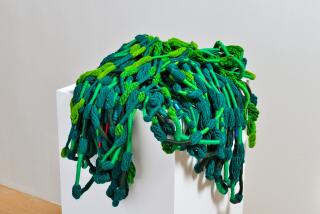You Got the Catalog; Did You Get the Joke?
Bored with the same old gifts?
Let Ceci N’est Pas Un Catalogue inject a little novelty into your holiday shopping. Ethnic cleansing bars, anyone? (“Select your color preference . . . and just lather up.”) How about a liver on a stalk? (“Point out realistic cirrhosis lesions to your dinner guests.”) Or a T-shirt with a modified Nike logo that says, “Just Blew It”? (“For the imperfect, underachieving, second-place finisher in all of us.”)
And there’s plenty more products we guarantee you’ve never seen, and almost certainly never will, among the 22 graphically snazzy pages. That’s because they’re just pretend. As a matter of fact, consider yourself lucky to even get hold of the catalog.
“Around this time of year, you just get barraged by all these catalogs, so I had the idea to create this sort of Dada-esque, virtual catalog of ridiculous products,” says graphic designer John Bielenberg, 38, the creator of Ceci N’est Pas Un Catalogue (or the Un-Catalogue, for short). “You know. They’re full of these things that kind of look neat but are stupid and nobody needs, like designer versions of items . . . say, an envelope opener designed by Alvar Alto or something. And it’s like $180. So I thought, ‘Ahh, this is a ripe area.’ ”
The idea germinated five years ago when Bielenberg, who divides his time between studios in San Francisco and Boulder, Colo., decided to prey on the sensibilities of his colleagues. His first satirical volley was a giant yellow and black poster with a cigarette ad-style warning box that read, “Warning: We’ve met the enemy and he is us.”
Graphic designers often think of themselves as artists who just happen to accept commissions, Bielenberg explains. “But the reality is that 99% of the practitioners are just churning out stuff that suits their clients’ objectives.”
Bielenberg should know. His clientele includes such financial behemoths as Shearson-Lehmann and Morgan Stanley, not exactly the type of corporations that would be keen on subjecting their images to avant-garde visual interpretations. So, to keep his creative side well-juiced, and to see who would notice, he began to churn out material that said virtually nothing.
In 1992, as the business world giddily hopped on the recycling bandwagon, Bielenberg put out a hard-bound book containing 100 pages of nothing but the sentence “This is printed on recycled paper.” It was his way of making “the ultimate statement about waste,” he says.
But it would take another project to get people from outside the hermetic graphic design world to pay attention: Virtual Telemetrix, a virtual corporation with a visually compelling but vacuous annual report.
To make it, Bielenberg solicited work from other designers, telling them to send him whatever they wanted “as long as it’s really cool and void of content.” Legitimate annual reports provided passages of bland corporate-speak, randomly selected with throws of a dart, for Telemetrix’s mission statement.
“I strung those [excerpts] all together and took out all the word spacing so it’s really difficult to read,” he says. “But I [also] reversed it out of black, with all caps. So it looks cool. And it’s amazing how few people even question that they can’t read it. They just kind of see it and say, ‘Oh, yeah.’ ”
In the back, where the numbers typically appear, readers find only one sentence: “Financial information not interesting at the time of publication.”
The Telemetrix report attracted calls from design competitions, whose sponsors never figured out that it was a parody, and some Wall Street hotshots missed the joke too. “I started getting calls from analysts who were asking for more information about the company,” Bielenberg says.
*
For the Christmas catalog, Bielenberg again turned to his peers for visually compelling but functionally absurd pieces. Within weeks, the 1,000 or so free copies had been snapped up. Next year, he intends to charge for it.
Buoyed by the attention, Bielenberg’s corporate alter-ego has taken on a life of its own. In addition to establishing a Web site (https://www.virtualtelemetrix.com), the Virtual Telemetrix board of directors (yes, actual co-conspiring designers) registered their invention as a nonprofit corporation. There are plans for a content-free design competition as well.
What all this has led to, ironically, is the designer who has made his name partly by chiding his peers for their artistic pretensions, now gaining recognition from that most rarefied institution of artistic expression--the museum.
“I saw John’s catalog and annual report, and was impressed by . . . [his] ability to use the forms and compositions that pervade our popular culture--including the niche of big business--to create a critical commentary that gained its power not from words or abstract ideas but from the medium itself,” says Aaron Betsky, curator of architecture and design for San Francisco’s Museum of Modern Art. Betsky has approached Bielenberg about doing a Virtual Telemetrix installation there.
Of course, that would have to wait until the Un-Catalogue hoopla subsides.
“The phones have just started dying down,” Bielenberg says. “We’ve been getting all these calls from people wanting to order up stuff. I have to tell them, it’s just a joke.”
The most popular non-item, he says, appears to be the “Just Blew It” T-shirt. But it is perhaps a testament to the public’s intelligence that no one took the Pufiel Prostate Pal--a home prostate examination kit consisting of a hand with its index finger extended--seriously enough to request one, despite being priced to move at $39.95.






